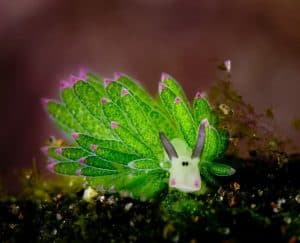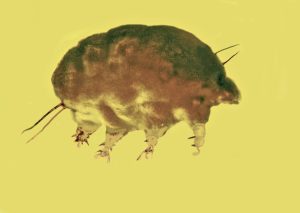Podcast: Play in new window | Download (Duration: 9:20 — 10.4MB)
Thanks to Murilo and an anonymous listener for their suggestions this week!
Further reading:
The ‘sheep’ that can photosynthesize
Meet the ‘mold pigs,’ a new group of invertebrates from 30 million years ago
A leaf sheep:

Shaun the sheep:

A mold pig:

Show transcript:
Welcome to Strange Animals Podcast. I’m your host, Kate Shaw.
This week let’s learn about two animals that sound like you’d find them on a farm, but they’re much different than their names imply. Thanks to Murilo for suggesting the leaf sheep, which is where we’ll start.
The leaf sheep isn’t a sheep or a leaf. It’s actually a type of sea slug that lives in tropical waters near Japan and throughout much of coastal south Asia. The reason it’s called a leaf sheep is because it actually looks a lot like a tiny cartoon sheep covered with green leaves instead of wool.
Back in episode 215 we talked about the sea bunny, which is another type of sea slug although it’s not closely related to the leaf sheep. The leaf sheep is even smaller than the sea bunny, which can grow up to an inch long, or about 25 mm. The leaf sheep only grows about 10 mm long at most, which explains why it wasn’t discovered until 1993. No one noticed it.
The leaf sheep’s face is white or pale yellow with two tiny black dots for eyes set close together, which kind of makes it look like Shaun the Sheep. It also has two black-tipped protuberances that look like ears, although they’re actually chemoreceptors called rhinophores. The rest of its body is covered with leaf-shaped spines called cerata, which are green and often tipped with pink, white, or black. This helps disguise it as a plant, but there’s another reason why it’s green.
The leaf sheep eats a particular kind of algae called Avrainvillea, which looks like moss or fuzzy carpet. While algae aren’t exactly plants or animals, many do photosynthesize like plants. In other words, they transform sunlight into energy to keep them alive. In order to photosynthesize, a plant or algae uses a special pigment called chlorophyll that makes up part of a chloroplast in its cells, which happens to be green.
The leaf sheep eats the algae, but it doesn’t digest the chloroplasts. Instead, it absorbs them into its own body and uses them for photosynthesis. That way it gets nutrients from eating and digesting algae and it gets extra energy from sunlight. This is a trait shared by other sea slugs in the superorder Sacoglossa. Because they need sunlight for photosynthesis, they live in shallow water, often near coral reefs.
When the leaf sheep’s eggs hatch, the larvae have shells, but as they mature they shed their shells.
This is a good place to talk about cyanobacteria, which was requested ages ago by an anonymous listener. Cyanobacteria mostly live in water and are also called blue-green algae, even though they’re not actually classified as algae. They’re considered bacteria, although not every scientist agrees. Some are unicellular, meaning they just consist of one cell, while others are multicellular like plants and animals, which means they have multiple cells specialized for different functions. Some other cyanobacteria group together in colonies. So basically, cyanobacteria looked at the chart of possible life forms and said, “yes, thanks, we’ll take some of everything.” That’s why it’s so hard to classify them.
Cyanobacteria photosynthesize, and they’ve been doing so for far longer than plants–possibly as much as 2.7 billion years, although scientists think cyanobacteria originally evolved around 3.5 billion years ago. The earth is about 4.5 billion years old and plants didn’t evolve until about 700 million years ago.
Like most plants also do, cyanobacteria produce oxygen as part of the photosynthetic process, and when they started doing so around 2.7 billion years ago, they changed the entire world. Before then, earth’s atmosphere hardly contained any oxygen. If you had a time machine and went back to more than two billion years ago, and you forgot to bring an oxygen tank, you’d instantly suffocate trying to breathe the air. But back then, even though animals and plants didn’t yet exist, the world contained a whole lot of microbial life, and none of it wanted anything to do with oxygen. Oxygen was toxic to the lifeforms that lived then, but cyanobacteria just kept producing it.
Cyanobacteria are tiny, but there were a lot of them. Over the course of about 700 million years, the oxygen added up until other lifeforms started to go extinct, poisoned by all that oxygen in the oceans and air. By two billion years ago, pretty much every lifeform that couldn’t evolve to use or at least tolerate oxygen had gone extinct. So take a deep breath of life-giving oxygen and thank cyanobacteria, which by the way are still around and still producing oxygen. However, they’re still up to their old tricks because they also produce what are called cyanotoxins, which can be deadly.
That brings us to another animal in our imaginary farm, the mold pig. It’s not a pig or a mold, and unlike the leaf sheep and cyanobacteria, it’s extinct. At least, we think it’s extinct.
The mold pig is a microinvertebrate only discovered in 2019. The only reason we know about it at all is because of amber found in the Dominican Republic, on an island in the Caribbean Sea. As we’ve discussed in past episodes, especially episode 108, amber is the fossilized resin of certain types of tree, and sometimes the remains of small animals are found inside. Often these animals are insects, but sometimes even tinier creatures are preserved that we would otherwise probably never know about.
The mold pig was about 100 micrometers long, or .1 millimeter. You’ve probably heard of the tardigrade, or water bear, which we talked about in episode 234, and if so you might think the mold pig was a type of tardigrade just from looking at it, since it looks similar. It had four pairs of legs like tardigrades do, but while scientists think they were related, and that the mold pig was probably also related to mites, it was different enough that it’s been classified in its own genus and may need to belong to its own phylum. Its official name is Sialomorpha.
The mold pig probably ate mold, fungus, and microscopic invertebrates. It lived around 30 million years ago, and right now that’s about all we know about it. There’s a good chance that it still survives somewhere in the world, but it’s so tiny that it’s even easier to overlook than the leaf sheep. Maybe you will be the person who rediscovers its living descendants.
You can find Strange Animals Podcast at strangeanimalspodcast.blubrry.net. That’s blueberry without any E’s. If you have questions, comments, or suggestions for future episodes, email us at strangeanimalspodcast@gmail.com. If you like the podcast and want to help us out, leave us a rating and review on Apple Podcasts or Podchaser, or just tell a friend. We also have a Patreon at patreon.com/strangeanimalspodcast if you’d like to support us for as little as one dollar a month and get monthly bonus episodes.
Thanks for listening!